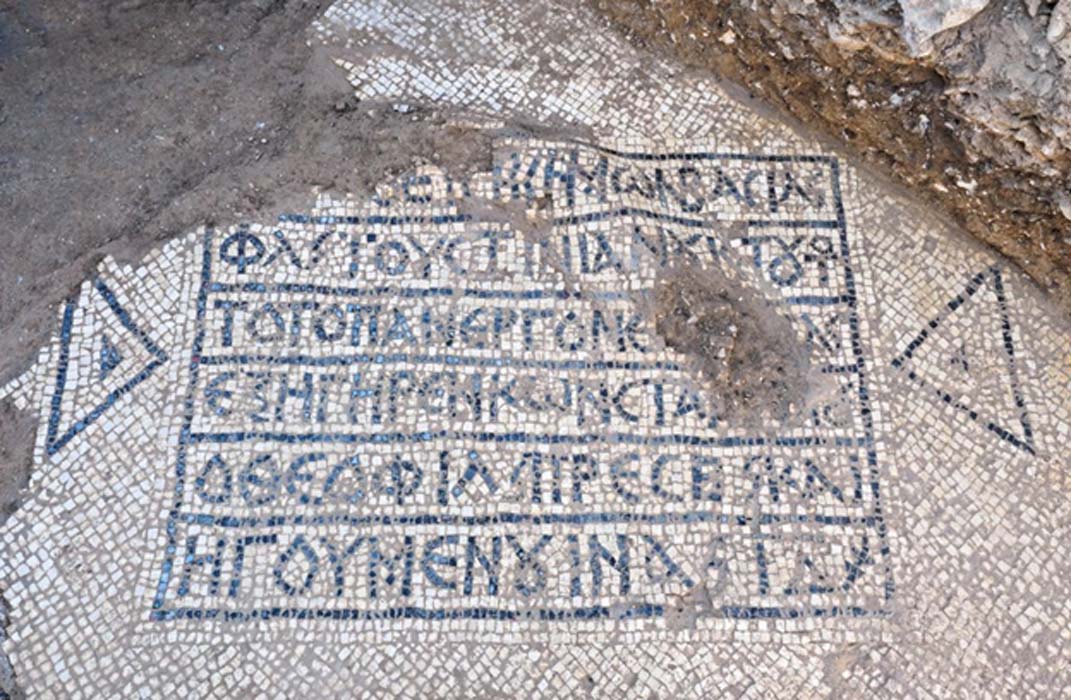A 1,500-year-old mosaic floor bearing Greek writing has been unearthed near Damascus Gate in Jerusalem’s Old City. Archaeologists describe the new find as a truly unique discovery of an ancient artifact and an historic document in one.
Workers digging in order to install communications cables in Jerusalem’s Old City, happened to uncover an intact mosaic with a Greek inscription, on what appears to have been the floor of an ancient version of a luxurious hostel 1,500 years ago. The Times of Israel reports that the inscription reads: “In the time of our most pious emperor Flavius Justinian, also this entire building Constantine the most God-loving priest and abbot, established and raised, in the 14th indiction,” as Leah Di Segni of the Hebrew University in Jerusalem deciphered. Di Segni, an expert on ancient Greek inscriptions, explained that “indiction” was an ancient method of counting years, for taxation purposes.

An ancient Greek inscription mentioning the Byzantine emperor Justinian was found at the Jerusalem Old City Damascus Gate, August 2017 (Assaf Peretz, Israel Antiquities Authority)
Mosaic Found in Great Condition
Israel Antiquities Authority director of excavation David Gellman was overseeing the earthworks ahead of the installment of Partner communications cable infrastructure outside American Consulate buildings in East Jerusalem. He described the new find as extremely exciting, and added that it is almost a “miracle” unearthing an ancient inscription in such a great condition, pointing out the importance of the discovery. “The fact that the inscription survived is an archaeological miracle,” an excited Gellman told The Times of Israel , as he went on explaining that the archaeological remains in that area had been seriously damaged by infrastructure groundwork over decades.
“The excavation in a relatively small area exposed ancient remains that were severely damaged by infrastructure groundwork over the last few decades. We were about to close the excavation when all of a sudden, a corner of the mosaic inscription peeked out between the pipes and cables,” he told The Times of Israel .

An ancient Greek inscription mentioning the Byzantine emperor Justinian was found at the Jerusalem Old City Damascus Gate, August 2017 (Credit: Assaf Peretz, Israel Antiquities Authority)
Amazingly, as Gellman joyfully said, the inscription was intact, a fact that made him happier than he could ever imagine, “My heart leapt out of my chest…Amazingly, it had not been damaged. Every archaeologist dreams of finding an inscription in their excavations, especially one so well preserved and almost entirely intact,” he tells The Times of Israel .
Mosaic Dates Back to the Byzantine Empire
Archaeologists suggest that the building, of which the mosaic was once part, was probably used as a hostel for pilgrims. After studying and examining the inscription, the researchers concluded that the mosaic dates back to around 550 or 551 AD, thus during Justinian’s reign. The nearly forty-year reign of Emperor Justinian (527–565) heralded extensive territorial expansion and military success, along with a new synthesis of Greco-Roman and Christian culture seen at all levels of Byzantine culture. In 543 AD he established the “Nea” Church in Jerusalem, one of the biggest Christian churches in the Byzantine Empire and the largest in Jerusalem at the time. According to historical accounts the “Nea” included a hospital, monastery and accommodation. Its abbot was Constantine, which explains why he and Emperor Justinian were mentioned in the inscription, as Di Segni explained to The Times of Israel.

Jerusalem’s Significance in the Byzantine Empire
Gellman believes that the construction of the hostel by Emperor Justinian on the Damascus Road shows the geopolitical significance of Jerusalem for the Byzantines back then. “In the Byzantine period, with the emergence of Christianity, churches, monasteries and hostels for pilgrims were built in the area north of the gate, and the area became one of the most important and active areas of the city,” he tells The Times of Israel . On the other hand, Di Segni focuses more on the present and explains how the new inscription could help researchers and historians to better understand Byzantine architecture in ancient Jerusalem, “This new inscription helps us understand Justinian’s building projects in Jerusalem, especially the Nea Church. The rare combination of archaeological finds and historical sources, woven together, is incredible to witness, and they throw important light on Jerusalem’s past,” he told The Times of Israel.
The mosaic, which was presented to the media yesterday, was discovered earlier during the summer. Conservation experts have currently removed the mosaic and are treating it in a specialist workshop.
Src: ancient-origins.net








